G. Wayne Miller's Blog, page 27
April 25, 2013
A Nearly Perfect Summer
Thirteen years ago, The Providence Journal published my tenth major newspaper series, A Nearly Perfect Summer: Travels Through Old-Money Newport, about the time I spent immersed in Newport Society. The six-part series, which ran from July 2 - July 7, 2000, was the basis for my 2010 documentary movie, Behind The Hedgerow.
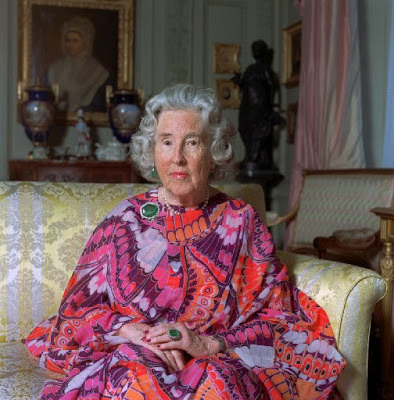
The late (and last) grand dame Eileen Slocum, central character in A Nearly Perfect Summer, the series, and Behind The Hedgerow, the documentary movie.
In our fickle world of technology, the series has disappeared from Journal servers (though it remains internally in our archives). So I was pleased to find a copy of Chapter Three, the whimsical 'Midsummer Nights,' on The National Museum of American Illustration site, virtual home of the museum that is owned and operated by my Bellevue Avenue friends Judy and Laurence Cutler.
So take a look at 'Midsummer Nights,' Chapter Three, in its original form.
Because he is retiring as Journal executive editor this week -- his last appearance in the newsroom is this afternoon, in fact -- I must mention my friend, colleague and mentor Tom Heslin. Tom edited the series, helping transform it with his exquisite touch into one of my most popular works ever. Thanks, Tom, and best of luck!
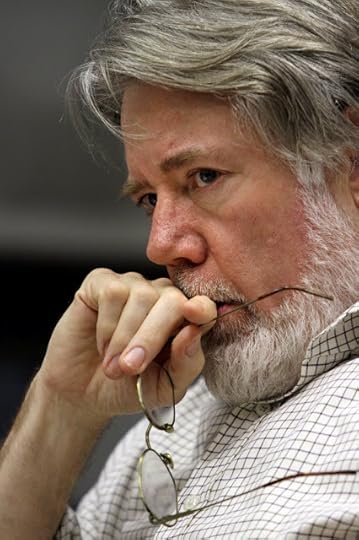
Tom Heslin, as we remember him from his three decades in the Projo newsroom
Published on April 25, 2013 08:08
April 13, 2013
1st Story in Public Square Conference a Success!
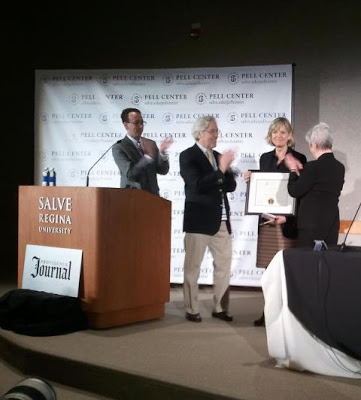
Jim Ludes, me, Dana Priest, and Sr. Jane Gerety, president of Salve Regina University.
More than 150 people braved a wet and windy spring Friday in Newport, R.I., to attend the launch of the Story in the Public Square program, a year-round initiative of Salve Regina University's Pell Center and The Providence Journal that will feature more events in months and years to come and an active ongoing online resource and presence, www.publicstory.org After more than a year of planning, Story co-director Jim Ludes and me agreed our launch was a success.
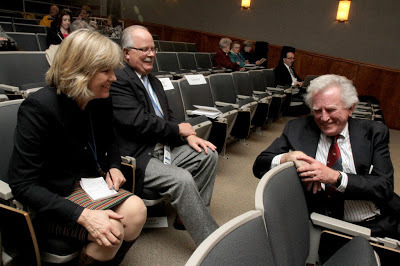
Dan Priest. Journal publisher and CEO Howard Sutton, and Gary Hart. Journal reporter Paul Grimaldi, who covered the event, is in background.
The conference featured the inaugural award of the Pell Center Prize for Story in the Public Square to The Washington Post's Dana Priest, above, two-time Pulitzer Prize winner. Former Colorado senator Gary Hart, below, delivered the keynote address in Salve's Bazarsky Hall.
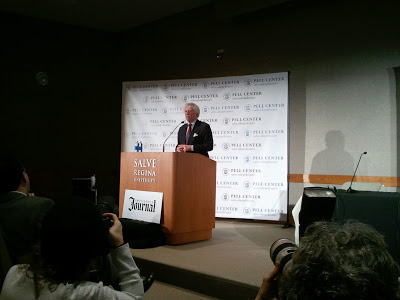
Gary Hart. "We need stories to tell us where we are [and] where we are headed," he said.
In the morning panel, print and broadcast storytellers, a community leader, and a best-selling novelist discussed ethical storytelling -- and told some compelling stories of their own.
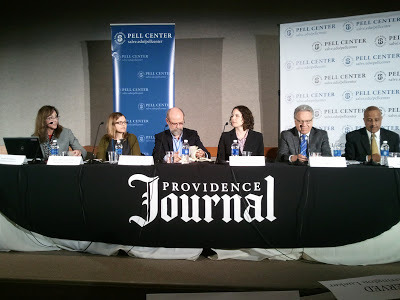
L to R: Moderator Karen Bordeleau, executive editor of The Providence Journal; novelist Karen Thompson Walker; BU professor Chris Daly; URI political scientist Shanna Pearson-Merkowitz; WBUR's David Boeri; and the NAACP's Jim Vincent.
The afternoon session included a screening of The Providence Journal's award-winning documentary, "Coming Home," and a discussion moderated by Salve professor Donna Harrington-Lueker with panelists Iraq war veteran John DiRaimo, a central figure in the film; the Rhode Island National Guard's Lt. Col. Richard Duffy; Journal columnist and film narrator Bob Kerr, a Vietnam veteran; Elizabeth Roberts, lieutenant governor of Rhode Island; and me.
We also honored the winners of our first annual student storytelling contest. First place wen to Sophie Zander, a junior at Ursinus College in suburban Philadelphia. Honorable mentions went to Ron Farina, a student at Central Connecticut State University, and Madelin Schlenz, a student at Community College of Rhode Island.
The conference was blogged and with the hash tag #SIPS13, got a lot of Twitter traction.
We urge Friday's participants to take a brief survey.
And we hope to see everyone at our fall event, topic TBD, and our 2014 spring conference. Please send any suggestions on topic, speakers, panelists, potential award winners and anything else to my email.
Published on April 13, 2013 05:01
April 11, 2013
Three-camera setup for Story in the Public Square
Salve Regina University is pulling out all the stops to ensure great coverage of the Friday, April 12, launch of the year-round Story in the Public Square program, a partnership of Salve's Pell Center for International Relations and Public Policy and The Providence Journal, with major grant support from the Rhode Island Council for the Humanities.
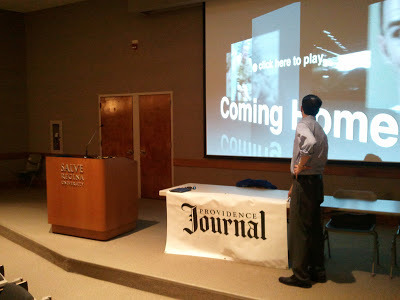
Pell Center head Jim Ludes checking the stage at Bazarsky Hall on Wednesday.
The day-long program will include a keynote address by Gary Hart, an award to Washington Post staff writer and two-time Pulitzer winner Dana Priest, two panels, and announcement of winners of the student story contest. Setup began on Wednesday...
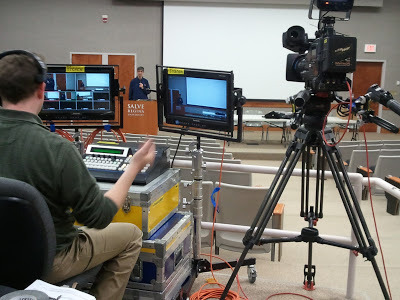
Salve Regina's Jamie McGuire, teacher and filmmaker, video production chief, on Thursday.
Footage from the conference will see a variety of uses, including a PBS broadcast and more. Jamie McGuire is using a three-camera setup, in Bazarsky Hall; another setup will be used in beautiful Ochre Court for interviews of key participants. We also expect good media coverage and lost of Tweeting -- hash tag for the event is #SIPS13 As in Story in the Public Square 2013, first of a series of annual spring conferences. Other events are planned throughout the year, and we have already established a vigorous online presence, please visit www.publicstory.org
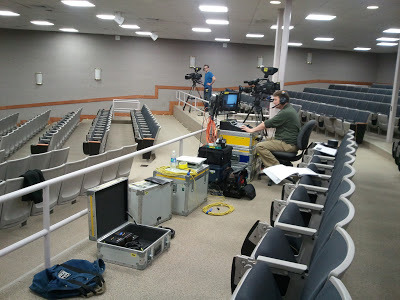
Two of the three cameras under Jamie's control.
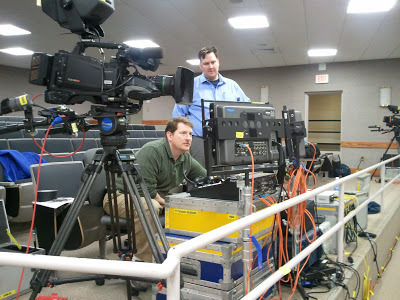
Checking the equipment late Thursday afternoon.

Pell Center head Jim Ludes checking the stage at Bazarsky Hall on Wednesday.
The day-long program will include a keynote address by Gary Hart, an award to Washington Post staff writer and two-time Pulitzer winner Dana Priest, two panels, and announcement of winners of the student story contest. Setup began on Wednesday...

Salve Regina's Jamie McGuire, teacher and filmmaker, video production chief, on Thursday.
Footage from the conference will see a variety of uses, including a PBS broadcast and more. Jamie McGuire is using a three-camera setup, in Bazarsky Hall; another setup will be used in beautiful Ochre Court for interviews of key participants. We also expect good media coverage and lost of Tweeting -- hash tag for the event is #SIPS13 As in Story in the Public Square 2013, first of a series of annual spring conferences. Other events are planned throughout the year, and we have already established a vigorous online presence, please visit www.publicstory.org

Two of the three cameras under Jamie's control.

Checking the equipment late Thursday afternoon.
Published on April 11, 2013 14:29
April 9, 2013
Novel 'Asylum' published: in memory of Frank Beazley, and to benefit Zambarano Hospital
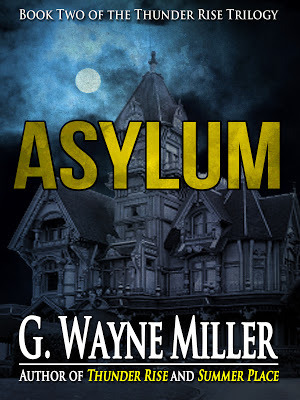
Crossroad Press has just published Asylum, the second book in my Thunder Rise trilogy (stay tuned for book 3, Summer Place). Asylum is available as an Amazon exclusive on Kindle.
Proceeds will benefit patients at state Zambarano Hospital, in Pascoag, R.I., home
of the late Frank Beazley, inspirational artist, poet, champion of the
disabled and my dear friend (proceeds will go to Patients for Progress, the fund Frank started). The story of Frank, in my 12-part 2006 Providence Journal series, is my favorite of the many narratives I have written. Frank died in 2012.
I hope Asylum will
appeal to readers of horror and mystery -- who may already have been
drawn into the vortex of the mountain I call Thunder Rise, in the
Berkshires of Massachusetts. The trilogy stories begin in my first
novel, Thunder Rise, first published in 1989 and recently re-released in digital format, and soon also to be an audio book.
Here is the blurb for Asylum on Amazon:
With
the support of his wife, Sharon, young neurosurgeon Nick Emin has left
medicine to pursue his longtime dream of architecture -- and now he has
just won his first big contract, to design a luxury resort from the
remains of an old state psychiatric hospital that lies in the shadow of
Thunder Rise. It seems his decision to quit operating was wise, after
all, despite the criticism he endured when he put down the scalpel.
Taking
up temporary residence near the long-closed Elmwood State Hospital,
Nick is slowly drawn into the institution -- and back in time, to when
Nazi-inspired experimental surgery on the mentally ill was conducted
behind the old brick walls of Elmwood. And not just lobotomy, once so
widely practiced in America...
The pull of Nick into Elmwood’s
past is no random development or horror-novel cliché. With his
neurosurgical expertise, Nick has been called for a specific reason, by a
specific person he will come to know well -- someone of great
importance to him. When Sharon becomes pregnant with their first child,
Nick begins to understand.
But first, the enigmatic Saint Peter
and his friends have a mission for Nick that pits him against Elmwood’s
inhumane administration -- a mission of salvation with terrible
consequences if it fails.
>>>><<<<
Asylum is
fictional, but its essential elements are real: the long, tragic
history of institutionalizing the mentally challenged and disabled, and
others society deemed as "unfit." This history spans America (and many
foreign nations), and Rhode Island, where I live, has its own shameful
past. Some of my earliest stories for The Providence Journal were about
abuses at the Ladd Center and Institute of Mental Health. In part
because of the public-service writing of The Journal, both institutions
are now closed. I invite you to read more about the impact of public story on public policy.
And take a moment to read the essay with which I introduce Asylum:
A note to readers
This is entirely a work of fiction. I created the characters and events.
But I did not create the historical circumstances in which Asylum is set.
Not
so very long ago –– within my memory as a journalist who covered their
dying days –– American institutions for the mentally ill and disabled
were as depicted in these pages: warehouses that often became
laboratories for the mistreatment of our fellow human beings. Residents
suffered needlessly, and endlessly. Time dragged. The real world faded
until it was gone. Hydrotherapy, insulin, electro-shock treatments,
lobotomy, forced sterilization, all of which are mentioned in this book
-- all were real. All were commonplace. Untold numbers of lives ended
beneath unnamed concrete markers in potter’s fields.
Since
the 1980s, when I began covering these issues for The Providence
Journal, many of these institutions have closed. I would like to be able
to report that our society’s treatment of the people who once filled
them has become more enlightened. And while there are some communities
where this is indeed the case, and while I know of one institution where
care is compassionate and first-class –– Zambarano Hospital, in
Pascoag, R.I., where Frank Beazley, to whom this book is dedicated,
lived for so long –– overall, little has changed. Many of the mentally
ill and disabled are now imprisoned –– one institution having replaced
another. Many are on the streets, lost, abandoned, and often abused.
Some are war veterans, which adds an additional layer of national shame.
And
all remain subject to ugly stigma that pervades our society. Stigma
that is based on the absurd notion that disorders of the brain are
somehow different than disorders of any other organ.
Are we so lacking in compassion?
Have we learned nothing?
Published on April 09, 2013 06:38
March 22, 2013
Creativity and spirituality
Elizabeth Gilbert, author of
Eat, Pray, Love
and other acclaimed works, speaks about the relationship of creativity and spirituality in the current issue of Spirituality & Health magazine. Highly recommended.
I found this passage particularly enlightening:
"I think creativity is entirely a spiritual practice. It has defined my entire life to think of it that way. When I hear the way some people speak about their work, people who are in creative fields who either attack themselves, or attack their work, or treat it as a burden rather than a blessing, or treat it as something that needs to be fought and defeated and beaten. . . . There is a war that people go to with their creative path that is very unfamiliar to me. To me, it feels like a holy calling and one that I am grateful for."
Read the full interview.

Elizabeth Gilbert, courtesy Spirituality & Health.
I found this passage particularly enlightening:
"I think creativity is entirely a spiritual practice. It has defined my entire life to think of it that way. When I hear the way some people speak about their work, people who are in creative fields who either attack themselves, or attack their work, or treat it as a burden rather than a blessing, or treat it as something that needs to be fought and defeated and beaten. . . . There is a war that people go to with their creative path that is very unfamiliar to me. To me, it feels like a holy calling and one that I am grateful for."
Read the full interview.

Elizabeth Gilbert, courtesy Spirituality & Health.
Published on March 22, 2013 03:56
March 20, 2013
Gina, Carlos, Don and Gil
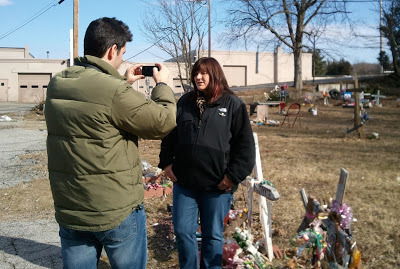
Carlos Ferreira and Gina Russo, Station site, 4 p.m., March 15, 2013.
I met Brazilian journalist Carlos Ferreira at the Providence
train station, where he had arrived on Amtrak Regional 172 from New York. We
stopped at the newsroom of The Providence Journal, where he met editors Karen
Bordeleau and Sue Areson, and reporters Tom Mooney and Tracy Breton. Like me,
they have long been involved in coverage of the Station nightclub fire.
Carlos, from the newspaper Zero Hora, published in Porto Alegre, a city of almost 2 million, is among the many journalists who have been covering the January
tragedy at Santa Maria nightclub club Kiss, where 242 died in a fire eerily
like the Station. He was here in America to write stories about our people touched
by our fire. He had reached out to me after I wrote an op-ed piece for his Brazilian newspaper group, where I had connected with editor Deni Zolin of Diário de Santa Maria.
I had arranged for him
to meet Gina Russo at the West Warwick club site. She got there about the same
time that we did on Friday afternoon. It was cold, but sunny.
Gina, one of the truly great people of Rhode Island -- we
are so lucky to have her -- talked with Carlos about her experiences and the experiences
of the families and friends of what she calls these “one hundred angels,” whose
memory she has vowed to keep alive even as she continues to help survivors heal. She gave him an autographed copy of her
book. At one point, I thought I saw a shadowy figure in the woods behind the
crosses. Next look, the figure was gone. I exchanged a puzzled look with Gina. She seemed to suggest that the unexplained was not uncommon here, on this sacred ground.
And then the figure reappeared: a bespectacled middle-age man with a
backpack and an old camera. When he stopped near the shrine to Derek Johnson,
whose father, Bob, I have written about, I went over and asked if he was a
friend of Derek. No, he said, but he had met “Mr. J.” during the
tenth-anniversary week and become a friend of Derek’s dad.
His name was Don Haddock, from near Boulder, Colorado. Shoots
only in black-and-white, only with real film, and only on his ancient Ricoh
camera. Not a professional photographer, though passionate about his work,
which is quite good, as I found visiting his website. He told me that when he
is inspired by an event, he will sometimes hop on a plane and go shoot it --
the 2010 BP oil spill, for example. When he heard about the tenth anniversary
of the Station fire, he decided to come. And when he got home after being here February
20, he didn’t have all the shots he wanted. So he got back on a plane, and here
he was.
When I introduced myself, his eyes grew wide. Well, maybe
not literally, but hearing my name took him back. A few years ago, he said, he
had found a short video whose images and sound -- the sound of wind chimes on a
cold winter day -- had moved him deeply. He had the video on his iPhone. Said
he watched it frequently, both haunted and soothed by the music and scenes.
Said it was one of the reasons he was so strongly compelled to fly in from
Colorado, to pay personal witness to this place with 100 crosses.
It was a video I shot on the sixth anniversary of the fire. It
has not been posted on The Journal web site for some time. I don’t even have a
copy.
Don thanked me profusely for creating it. I didn’t know what
to say. Four years, 2,000 miles, Brazilian visitor Carlos, survivor Gina, a
Friday afternoon in March, a stranger who hopped on a plane -- could this be only
coincidence? I have felt many powerful emotions in my many visits to the site: among them, sadness, anger, admiration for people like Gina. This was a different kind of power, something at once remarkable and strange.
So I introduced Don to Carlos and Gina. Four of us, from
such different worlds, literally and figuratively, brought together for one
moment.
And as we four stood there talking, cars began to pull in.
One had two men who knew no one directly involved in the fire, but who had always
wanted to visit, and this was the day they chose. Another car had two women I
did not speak with; another, a man with a boy. And still another, with New
Hampshire plates, was driven by Gil Talbot, a professional photographer. He was
here to shoot the University of New Hampshire hockey team, which was playing in
Providence that evening. He, too, knew no one from the fire, but had wanted to
visit the site since reading John Barylick’s book, Killer Show.
So I introduced him to Gina -- and to Carlos and Don.
An hour or so had passed. The sun was weakening; it was time
for new friends to part. I suppose it was like that many nights when music
played and people talked and laughed and swapped stories at The Station... many
nights, that is, until the last.
Gina and Gil left. Carlos wanted to see some more of West
Warwick, as did Don, who had gotten to the site by bus, so I drove them around
the town, past abandoned mills. Then we drove to Warwick, where I dropped
Carlos at his hotel and Don at the airport.
I headed home, pondering the meaning of chance.
Published on March 20, 2013 04:09



